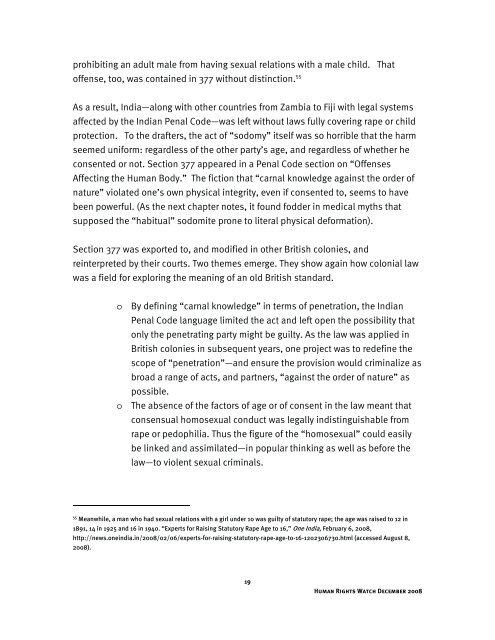This Alien Legacy
This Alien Legacy - Human Rights Watch
This Alien Legacy - Human Rights Watch
- No tags were found...
Create successful ePaper yourself
Turn your PDF publications into a flip-book with our unique Google optimized e-Paper software.
prohibiting an adult male from having sexual relations with a male child. That<br />
offense, too, was contained in 377 without distinction. 55<br />
As a result, India—along with other countries from Zambia to Fiji with legal systems<br />
affected by the Indian Penal Code—was left without laws fully covering rape or child<br />
protection. To the drafters, the act of “sodomy” itself was so horrible that the harm<br />
seemed uniform: regardless of the other party’s age, and regardless of whether he<br />
consented or not. Section 377 appeared in a Penal Code section on “Offenses<br />
Affecting the Human Body.” The fiction that “carnal knowledge against the order of<br />
nature” violated one’s own physical integrity, even if consented to, seems to have<br />
been powerful. (As the next chapter notes, it found fodder in medical myths that<br />
supposed the “habitual” sodomite prone to literal physical deformation).<br />
Section 377 was exported to, and modified in other British colonies, and<br />
reinterpreted by their courts. Two themes emerge. They show again how colonial law<br />
was a field for exploring the meaning of an old British standard.<br />
o By defining “carnal knowledge” in terms of penetration, the Indian<br />
Penal Code language limited the act and left open the possibility that<br />
only the penetrating party might be guilty. As the law was applied in<br />
British colonies in subsequent years, one project was to redefine the<br />
scope of “penetration”—and ensure the provision would criminalize as<br />
broad a range of acts, and partners, “against the order of nature” as<br />
possible.<br />
o The absence of the factors of age or of consent in the law meant that<br />
consensual homosexual conduct was legally indistinguishable from<br />
rape or pedophilia. Thus the figure of the “homosexual” could easily<br />
be linked and assimilated—in popular thinking as well as before the<br />
law—to violent sexual criminals.<br />
55<br />
Meanwhile, a man who had sexual relations with a girl under 10 was guilty of statutory rape; the age was raised to 12 in<br />
1891, 14 in 1925 and 16 in 1940. “Experts for Raising Statutory Rape Age to 16,” One India, February 6, 2008,<br />
http://news.oneindia.in/2008/02/06/experts-for-raising-statutory-rape-age-to-16-1202306730.html (accessed August 8,<br />
2008).<br />
19<br />
Human Rights Watch December 2008




